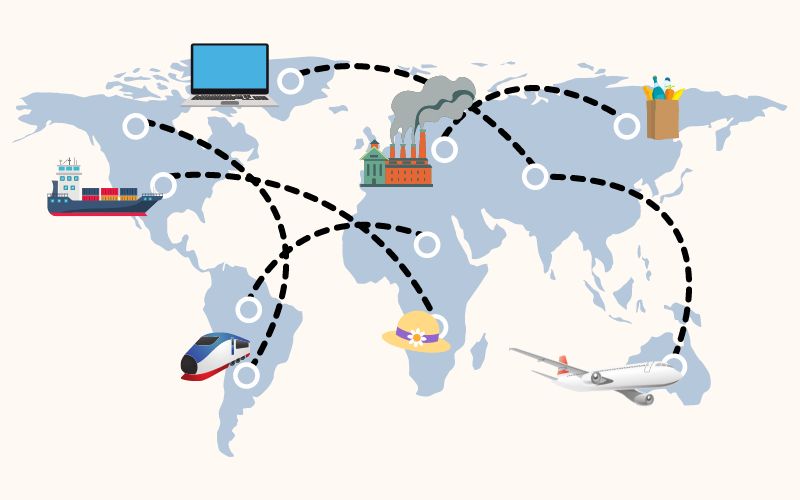Global Value Chains: Is India Ready?

This blog post has been authored by Manish Vaidya, Economics Researcher at Arthashstra Intelligence
What are Global Value Chains?
A value chain, is the range of activities undertaken by a firm, to bring a product from its conception stage to the final end-use product.
Global Value Chains (GVC) are cross-border networks, that bring a product or service from its conception to market. It refers to the range of economic activities undertaken. This chain consists of all stages, the pre-production stage (inception and design), the production stage, and finally the postproduction stage. These activities may take place in different parts of the world. In the most layman and sharp sense, GVCs are networks of production and trade across countries.
For instance, say “Country A” produces cars. It imports parts for the car from other countries and has outsourced various other activities like R&D, marketing, and customer care, to other countries subsequently, this is similar to Adam Smith’s “Division of Labour” proposition, taking place across borders. Hence, this is an instance of a GVC.
GVCs are efficient, specialized, and interconnected, but are prone to various global risks. Trade policy shocks, and supply chain shocks stemming from global events like COVID-19 and the Russian invasion of Ukraine, sparked questions about the resilience of GVCs.
India’s Position
Various government initiatives like Make In India, Skill India & Startup India have been set up to improve India’s positioning in the GVCs. Currently, India accounts for only 1.3% of the total GVC exports. This is way lesser than many of the small economies. For India to benefit from GVC it need not specialize in the entire value chain, but only the relevant and beneficial part of the chain which aligns with India’s infrastructure, and competitive edges. There are quite a few internal hindrances that make the existing export infrastructure unfriendly for GVCs. Weaker infrastructure, mobility issues, and other shortfalls reduce the firms’ competitiveness and hamper their prospects to be a part of GVCs.
Value addition parameters can be used to assess the positioning and potential of GVC participation by countries. Fig 1 shows Trade in Value added (TiVA), on gross consumption of all commodities.
Source: OECD; Compilation and Visualization By Arthashastra Intelligence.
Trade-oriented value addition on the final consumption of commodities in India has been rising and is bound to rise. This indicates, the significant role of international trade, and that the value chains are becoming more and more globalized with time. Fig 2, shows the foreign value added, on all yearly aggregate exports of goods and services.
Source: OECD; Compilation and Visualization By Arthashastra Intelligence.
Research by Asian Infrastructure Bank found that in order to increase GVC exports, it is necessary to reduce costs for inland factories to engage in exports. Ports with better connectivity with greater inland connectivity, tend to have higher exports. Hence the pitfalls are mostly infrastructure related and institutional in nature. The first move in the direction to increase GVC exports will be to address these pitfalls, and frame policies accordingly.
Many companies are in search of alternatives to China, this provides India with ample GVC opportunities, this is furthered by the fact that companies are revising and altering value chains, post the recent shocks and geopolitical developments. However, as discussed earlier, reports and surveys posit that companies have been stressing the basic necessities for GVC, i.e digital and physical infrastructure, trade policy, investments in human development, institutional and standards frameworks, etc are yet the talking points.
The first move in the direction to increase and improve GVC exports would be to address the aforementioned pitfalls, and most importantly the government e playing a bigger role is certainly needed.
The “Make in India’, program is a step in this direction, mainly to increase GVC participation in the manufacturing sector. A recent econometric study found that GVC-oriented backward linkages with advanced economies have led to an increase in TFP (total factor productivity), in the manufacturing sector. This highlights the positive implications of GVC trade in terms of increased productivity, wealth effects, and most importantly, the exchange of human capital and information.
References:
- K.L. Krishna, Bishwanath Goldar, Deb Kusum Das, Suresh Chand Aggarwal, Abdul A. Erumban, Pilu Chandra Das, Chapter 6 – Manufacturing productivity in India: the role of foreign sourcing of inputs and domestic capacity building, Editor(s): Barbara M. Fraumeni, Measuring Economic Growth and Productivity, Academic Press,2020, Pages 95-116
- Retrieved from Asian Development Bank (Author: Asian Development Bank) Global Value Chain Development Report 2021: Beyond Production
- Retrieved from Industrial Analytics Platform (Author: Adnan Seric and Yee Siong Tong) What are global value chains and why do they matter?
- Retrieved from Business Today (Author: Dr. Abhijit Sen Gupta) How India can better integrate with global value chains
- Retrieved from Observer Research Foundation (Author: Terri Chapman, Jhanvi Tripathi, and Rakesh Kumar Sinha) Building Resilient Global Value Chains Linkages in India: Findings from an Enterprise Survey
